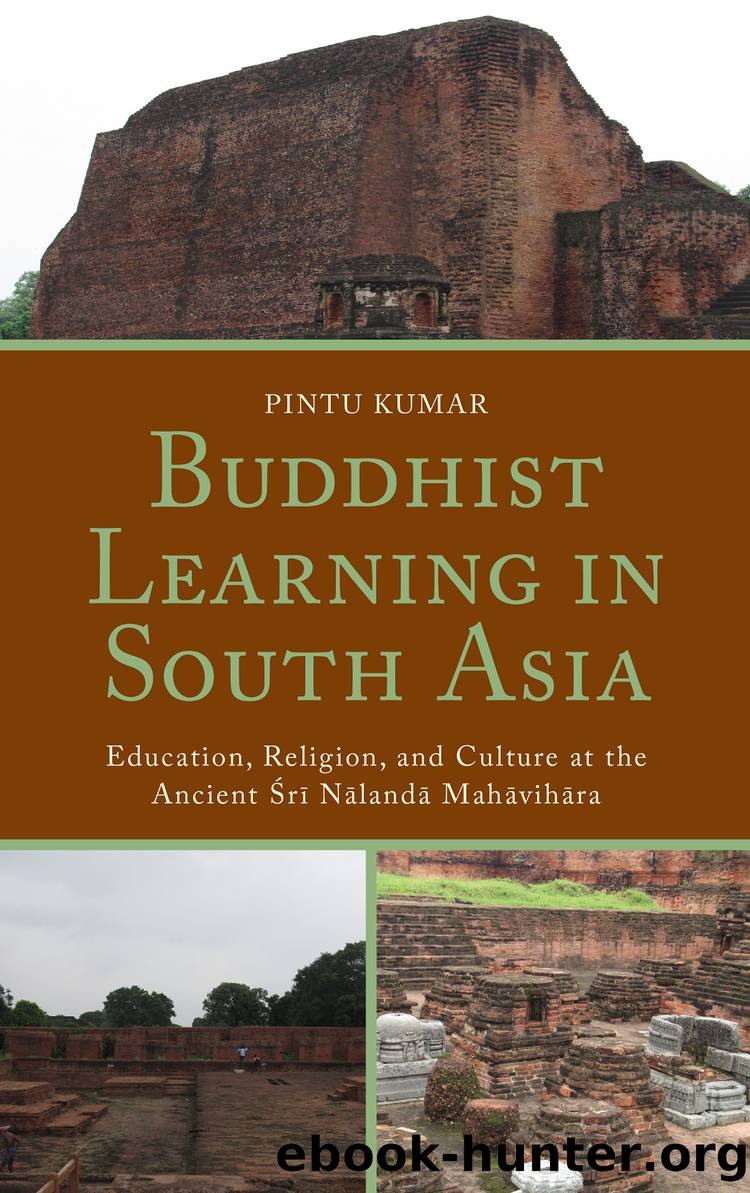Buddhist Learning in South Asia by Kumar Pintu;

Author:Kumar, Pintu; [Kumar, Pintu]
Language: eng
Format: epub
Publisher: Lexington Books/Fortress Academic
Published: 2018-05-18T00:00:00+00:00
Five
ÅrÄ« NÄlandÄ and Buddhist Learning
The last chapter brought up a picture of ÅrÄ« NÄlandÄ MahÄvihÄra as an institution devoted to Buddhist teaching and learning. Starting as popular traditional places of salvation, Buddhist monasteries like ÅrÄ« NÄlandÄ played a growing role in the evolution of religion, religious knowledge, philosophy, and science. Probably, NÄlandÄ was the first monastic learning organization of South Asia as the main center of learning for the MahÄsÄá¹ghika School, intimately attached to the teachings of the Buddha, quite earlier than its Christian counterparts in Europe started teaching Buddhist life by the third Buddhist council, although archaeological pieces of evidence do not support that much antiquity. It is also consistent with the fact that students entered NÄlandÄ as novices, monastics, Åramaá¹as, or upÄsakas, and eventually became TheravÄdins who may or may not have upheld a complementary MahÄyÄna philosophy and practice. Later, the literary famous first generation of abbots like NÄgÄrjuna, Äryadeva, and CandrakÄ«rti established the MahÄyÄna school of Buddhism at NÄlandÄ. In due time, the monastery of NÄlandÄ became more inclined towards mystic MahÄyÄna, and its teachers assimilated and promoted Tantric Buddhism in its curriculum and activities. Once the Buddhist faith took shape on the campus, ÅrÄ« NÄlandÄ played a significant role in the propagation of Buddhist learning and religion into Central, East, and South Asia. Here, we will focus on the study and training carried out at the MahÄvihÄra of NÄlandÄ related to the growth of Buddhist learning. In this way, the present chapter discusses the curriculum of NÄlandÄ, exploring both religious and scientific contents. The religion of the Buddha was the base and inspiration of the study and training at ÅrÄ« NÄlandÄ, and the changes in Indian Buddhism also transformed the curriculum of NÄlandÄ, which we will also see.
Monks have been the primary bearers of the intellectual tradition of the NÄlandÄ system of education. The renouncers became monks out of love for learning and Buddhism, dedicated to the monastic life starting from the establishment of ÅrÄ« Nalendra. ÅrÄ« NÄlandÄ MahÄvihÄra prominently being a residential place of Buddhist monks also indicates that the monks created and maintained the monastery of NÄlandÄ and its life and traditions. The monks became the cynosure of all activities within the monastery. They learned the Buddhist literature and life from their ÄcÄryas and upÄjjhÄyas and later trained and taught monks, laity, and upÄsakas. There was a long and venerable tradition of Paá¹á¸itas related to NÄlandÄ, going back at least as far as Paá¹á¸it NÄgÄrjuna. A monk taught another monk in a graduated manner and passed on the legacy. They learned the Buddhist scriptures and became knowledgeable. Over time, they might have devised a curriculum based on the tradition of learning, which was necessary to know in the proper manner. The school curricula, especially, became a need for an institution of studies like NÄlandÄ, suitable for its survival and popularity. Unfortunately, we do not have all the details of this basic curriculum, but the scholars who studied at NÄlandÄ provide us with some information about the practice of research and learning.
Download
This site does not store any files on its server. We only index and link to content provided by other sites. Please contact the content providers to delete copyright contents if any and email us, we'll remove relevant links or contents immediately.
The Daily Stoic by Holiday Ryan & Hanselman Stephen(3130)
The Fate of Rome: Climate, Disease, and the End of an Empire (The Princeton History of the Ancient World) by Kyle Harper(2893)
People of the Earth: An Introduction to World Prehistory by Dr. Brian Fagan & Nadia Durrani(2633)
Ancient Worlds by Michael Scott(2516)
Babylon's Ark by Lawrence Anthony(2447)
Foreign Devils on the Silk Road: The Search for the Lost Treasures of Central Asia by Peter Hopkirk(2393)
The Daily Stoic by Ryan Holiday & Stephen Hanselman(2369)
India's Ancient Past by R.S. Sharma(2315)
MOSES THE EGYPTIAN by Jan Assmann(2290)
The Complete Dead Sea Scrolls in English (7th Edition) (Penguin Classics) by Geza Vermes(2154)
Lost Technologies of Ancient Egypt by Christopher Dunn(2133)
The Earth Chronicles Handbook by Zecharia Sitchin(2113)
24 Hours in Ancient Rome by Philip Matyszak(1985)
Alexander the Great by Philip Freeman(1974)
Aztec by Gary Jennings(1890)
The Nine Waves of Creation by Carl Johan Calleman(1799)
Curse Tablets and Binding Spells from the Ancient World by Gager John G.;(1780)
Before Atlantis by Frank Joseph(1750)
Earthmare: The Lost Book of Wars by Cergat(1726)
